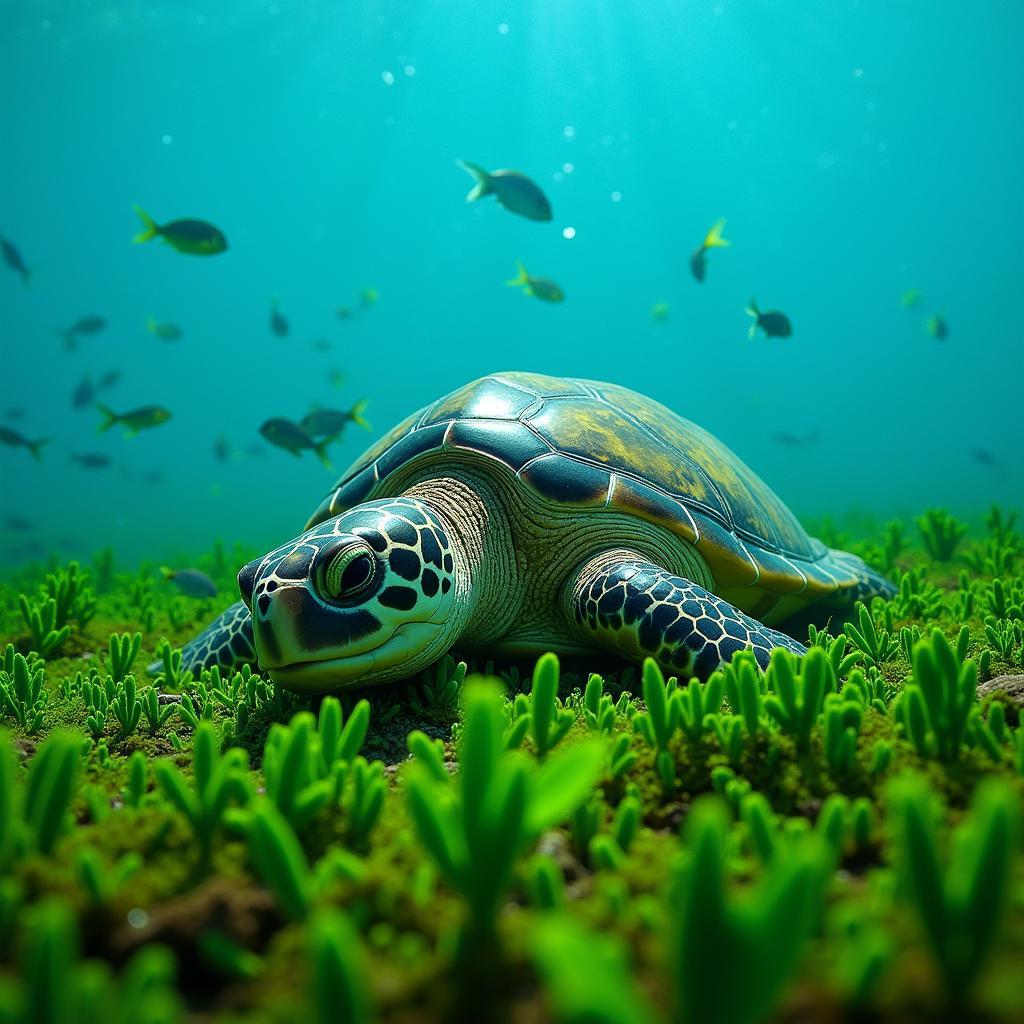The Food Web Of A Turtle is a fascinating glimpse into the interconnectedness of life in various ecosystems. From the smallest insects to the largest predators, understanding a turtle’s diet reveals much about its role in maintaining a balanced ecosystem. Let’s dive into the intricate world of what turtles eat and who eats them.
 Green sea turtle feeding on seagrass
Green sea turtle feeding on seagrass
What Do Turtles Eat? A Deep Dive into their Diet
Turtles, both terrestrial and aquatic, have incredibly diverse diets depending on their species and habitat. Some turtles are herbivores, munching on seagrass, algae, and various aquatic plants. Others are carnivores, feasting on insects, fish, jellyfish, and even small mammals. And then there are omnivorous turtles, enjoying a mix of both plants and animals. This dietary variety plays a crucial role in maintaining the food web of a turtle. For example, green sea turtles grazing on seagrass beds help keep these underwater meadows healthy, which in turn provides habitat for a multitude of other marine creatures.
What does a sea turtle eat in the deep sea? Well, leatherback sea turtles primarily consume jellyfish, playing a key role in controlling jellyfish populations. This is a perfect example of how the sea turtle food web contributes to ocean health.
The Herbivorous Turtle: A Gardener of the Sea
Herbivorous turtles, like the green sea turtle, are essential for maintaining healthy aquatic ecosystems. Their constant grazing helps control plant growth and prevents overgrowth, ensuring biodiversity. These turtles also contribute to nutrient cycling, enriching the environment. They truly are the gardeners of the sea.
Who Eats Turtles? Predators and Threats
While turtles have a tough shell for protection, they are not invincible. Hatchlings are especially vulnerable, facing threats from a wide range of predators, including birds, crabs, and even other reptiles. Adult turtles may fall prey to larger predators like sharks, crocodiles, and alligators. Human activity, such as habitat destruction and pollution, also poses a significant threat to turtle populations worldwide. Understanding the food web of a turtle also means understanding the challenges they face.
Protecting Turtles: Conservation Efforts
Numerous organizations are dedicated to turtle conservation, working tirelessly to protect these ancient creatures and their habitats. Efforts include protecting nesting sites, rescuing injured turtles, and raising awareness about the importance of these creatures to our ecosystems. Check out our article on the food web of a sea turtle to learn more about how we can all contribute to their survival.
Conclusion: The Interconnected Web
The food web of a turtle is a complex and dynamic system, essential for maintaining balanced ecosystems. From their role as grazers to their position as prey, turtles play a vital role in the health of our planet. Understanding and protecting these incredible creatures is crucial for the future of our planet. Remember to learn more about fsm foods to broaden your understanding of various food systems.
Expert Quotes:
- Dr. Emily Carter, Marine Biologist: “Turtles are indicator species, reflecting the overall health of their environment. Their declining numbers are a warning sign that we need to take action.”
- Professor John Davis, Ecologist: “The food web of a turtle highlights the delicate balance of nature. Protecting turtles means protecting entire ecosystems.”
FAQ:
- What is the primary food source of a green sea turtle? Seagrass and algae.
- What are some predators of baby turtles? Birds, crabs, and other reptiles.
- How do humans impact the food web of a turtle? Habitat destruction and pollution.
- What do leatherback sea turtles primarily eat? Jellyfish.
- Why are turtles important to the ecosystem? They help maintain healthy populations of plants and animals.
- What can we do to protect turtles? Support conservation efforts and reduce our impact on the environment.
- Are all turtles herbivores? No, some are carnivores and some are omnivores.
For further information, explore our articles on deep sea food and bird food sticks.
Need support? Contact us 24/7 at Phone: 02437655121, Email: [email protected] or visit our address: 3PGH+8R9, ĐT70A, thôn Trung, Bắc Từ Liêm, Hà Nội, Việt Nam.